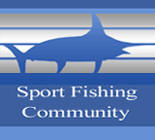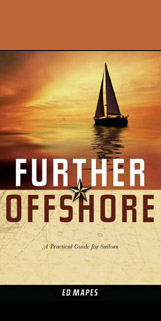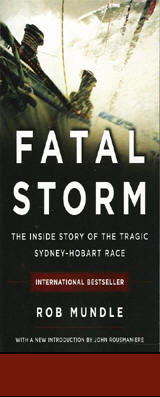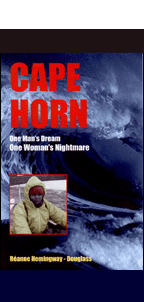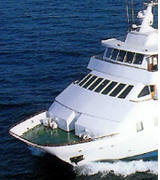|
|
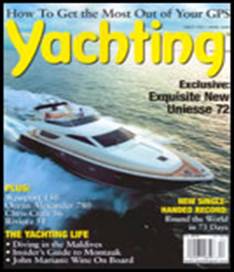
“The cruise of Sea Bird”
By F. B. Thurber
appearing in the 1945 issue of Yachting.
In 1911, when “Sea Bird” and her three-men
crew started on their voyage to Rome via the Azores, long ocean passages
in relatively small boats were an almost unheard of yachting practice.
This voyage marked the beginning of deep water cruising by yachtsmen in
small boats. “Sea Bird” was a 25-foot yawl with a draft of 3 feet 8
inches.
Thorough preparations were made in getting the Sea Bird ready for sea.
These included stocking provisions for 40 days as well as ordering new
sails and new running and standing rigging. All of the latter was of
extra strength. We also installed a 3 hp. Knox engine which consumed 15
gallons of either gasoline or kerosene in 24 hours and gave the boat a
speed of 3 ˝ knots in smooth water. Two 20-gallon fuel tanks were
installed under the transom and a reserve tank holding 10 gallons was
placed in the cockpit. Our drinking water was carried in two 15-gallon
tanks, in addition to 12 two-quart bottles.
We carried enough fresh food for the first three or four days, while our
canned food consisted principally of soups, corned beef, salmon, beans,
fruit and sardines. Other stores included jams, pickles, 48 packages of
crackers, five pounds of pilot bread, ten loaves of bread, three jars of
butter (over which paraffin was poured), onions, potatoes, several
pounds of tobacco and a dozen quarts of liquor.
The Cabin, which was to be our home for 40 days, measure 8 by 6 feet and
had but 4 feet 6 inches headroom. The transom had hard cork cushions;
one transom was built out a foot or so that one could recline on it
without having to lie under the side deck. As the other was almost
entirely under the deck with less than 12 inches between the deck and
the cushion, one could turn over only with difficulty! The engine was
under the bridge deck aft where there was less than three feet of height
between the floor and the deck. In the after part of the cockpit was a
box one side of which was used for tools, lashings and other deck gear,
while the other contained a three-gallon kerosene tank. A five-gallon
kerosene tank was also installed in the forward end of the cockpit. With
all this additional weight, besides that of the crew, the Sea Bird
floated three inches below her lines and, as her freeboard was anything
but generous, this made her look very low in the water.
We had set Saturday, June 10th, for our departure, as we wished to
arrive at Rome by July 20th, the date on which the competing motor boats
were due. This gave us but 40 days to reach our objective and Sea Bird
must average more than 100 miles per day, as a sailing vessel is often
obliged to cover much more than 100 miles in distance to make 100 miles
on her course. As 100 miles a day is a fair average for a large sailing
ship, we were aware of the task before us. It is a well-known fact that
June is the best month for crossing the Atlantic, for at that time of
year the prevailing winds blow from the south and west. Hence we
anticipated little head wind. We also realized that the Gulf Stream
would favor us with from 15 to 30 miles of current per day.
A letter was given us by Mayor Fletcher, of Providence, to deliver to
the Mayor of Rome, and this we carefully put in an oiled silk envelope.
We also carried a Bill of Health but we were not successful in obtaining
ship’s papers as we were of only 3 ˝ tons register and the government
does not document vessels under five tons. However, the Collector of the
Port at Providence kindly gave us a certificate adorned with brilliantly
colored seals, which we knew would please the Portuguese and Italian
officials.
By noon of the 10th everything was aboard. There was a great deal of
handshaking and well wishing by the crowd of yachtsmen who had assembled
at the Rhode Island Yacht Club to see us off. At 1:55 p.m., five minutes
before the start, the crew went aboard. Commodore Massie then stepped to
the edge of the dock and made a farewell speech and presented each of us
with a gold mounted pipe. Captain Day replied appropriately and, at the
conclusion of his speech, a gun was fired as a signal to start. We
slipped our mooring lines, started the engine and, under sail and power
and with the American and Italian flags flying, proceeded down the bay.
Sea Bird arrived at Newport at 5:30 p.m. and, as there was no wind, we
proceeded out through the Narrows under engine. The sea was smooth
outside and scarcely had we cleared Brenton’s Reef Light Vessel than a
hard shower approached. Our first night at sea was neither exciting nor
pleasant, with little wind and frequent rain squalls. Our course was ESE
17 miles to Vineyard Sound Light Vessel, which was passed at 11:00 p.m.,
and at 5:45 the next morning we reached Oak Bluffs on Martha’s Vineyard
where we were to secure an additional compass belonging to Captain Day
and take on more fuel. Thirty gallons, in five gallon cans, were
obtained, of which four cans were placed in the cockpit. This reduced
the area of that space to four feet wide by 18 inches long. Two other
cans were lashed between the mizzen shrouds. In addition, we carried a
can each side in the main shrouds and 21 one-gallon tins were lashed on
the starboard side of the house. This made a total of about 100 gallons
of fuel or sufficient for six days’ running.
At 9:30 a.m., we cleared the harbor. Full of the importance of the
occasion, the harbor master aluted us with a shotgun, with the result
that in a few seconds buckshot rained down on and about us like
hailstones! As the wind was light, the engine was kept going and at noon
Sunday we took our departure from Wasque Point, Martha’s Vineyard. By
one o’clock, we had reached the smooth water beyond Muskeget and headed
ESE for the light vessel some 60 miles away. At 4:00 p.m., when well
south of Nantucket, we picked up a nice sailing breeze and stopped the
engine.
With three in the crew, our schedule of watches gave us four hours on
and eight off when the weather was pleasant. However, if squally, we
were called out to shorten sail as many as three or four times in a
watch. The sensation of being suddenly awakened out of a sound sleep to
come on deck, where you would be drenched by spray, into a night as
black as your hat, is not conducive to a genial temper.
At 4:30 a.m., Monday, the steam chime whistle on the light vessel was
picked up and at 5:45 we passed close aboard, and asked to be reported.
Our course now lay nearly 1,900 miles due east, but it was our intention
to sail SE until the 38th parallel was reached, thus getting across the
Gulf Stream and into more settled conditions as quickly as possible.
However, the wind headed us so that the best course we could then make
was east. By 8:00 a.m., the sun threatened to come out but was soon
obscured and shortly thereafter the fog came in as thick as mud. Before
long, the wind had freshened so that jib and mizzen were all the Bird
could carry. Crossing the westbound steamer lane was not particularly
agreeable under such conditions and kept us on the alert every minute.
By eleven o’clock the fog cleared somewhat, the wind shifted to the SW
and we were enabled to make good our SE course.
In the afternoon the wind came in light from ahead with fog, giving us
no sights that day. Fog continued thick up to midnight, and the lumpy
sea made our going slow. As we approached the edge of the Stream, the
fog was cleared away by squalls, preceded by thunder and lightning.
During this time we lay to under jib and mizzen. We were now well in the
Stream as was evident from the confused condition of the sea, and the
ever present Gulf weed. By 8:00 a.m., the atmosphere cleared, enabling
us to take a longitude sight, after which the wind came in fresh from
SbyE so that we were making a good six knots.
During all of Tuesday afternoon the wind held SbyE and we ran along on
an easterly course. Sea Bird was so heavily loaded that she made little
progress unless the sheets were started. That day we obtained the first
good sight since our departure and found our position to be 40 20’ N, 68
12; W, which placed us some 50 miles north of our course.
After midnight, we made fast time with wind on the starboard quarter and
early in the morning we doused the jib and double reefed the main. Under
this short canvas, Sea Bird tore along in fine style. By seven o’clock,
we ran into more rain squalls, which were followed by short periods of
calm. During this interval we took up the slack of the jibstay and went
in swimming. The water of the Gulf Stream was beautifully clear and blue
and delightfully warm and we decided that if anyone would be able to
keep a supply of it at some resort, he would make his fortune. At 8:00
a.m., the wind again came in from the SSW and we logged six knots until
noon.
That afternoon a fine quartering breeze was picked up but, in the
evening, we ran into squally weather and were kept busy reefing and
shaking out all night. Wednesday morning dawned with light air, calms
and rain squalls. It was then that we discovered that the Bird was
making water quite rapidly. Investigation found it to be from the
stuffing box around the shaft and, although we tried every means of
stopping it, the leak persisted. We found, much to our relief, that it
did not increase, but leaked about the same amount every watch. It was
necessary to pump her every four hours and sometimes twice in a watch, a
practice which had to be continued for the rest of the trip.
Having water continually in the bilge was most annoying, while a leak in
the deck forward, which even the skipper’s ingenuity could not remedy,
kept the blankets and stores forward in a soggy condition. Kerosene,
which leaked from the crankcase into the bilge, had by this time
saturated nearly everything in the boat. It even found its way to the
potatoes! However, we were able to use them by paring them down to the
kerosene line and then adding plenty of salt. Another cheerful discovery
was made in the afternoon. When drawing a glass of water from one of the
tanks, we found that salt water had leaked into it through the deck
plate. At first we thought we might be faced with a scarcity of water
but, after checking our other tank and bottles, we concluded that we had
enough. Nevertheless we did use the salty water for our coffee, which
did not improve the taste of it or appeal to the skipper.
Now a word about our sleeping accommodations. As expected, once on our
way we proceeded on the starboard tack which we held for 20 days. The
lee bunk was always the choice, hence if two were below during the same
watch the unlucky wretch on the weather berth had his troubles. By lying
flat on one’s stomach, with arms and legs extended spread eagle fashion,
one would be able to hold his position until the Bird took an extra
heavy lurch, which would throw him on the floor or on top of the man on
the other bunk. After I had been precipitated in this manner several
times in one night, I decided to lash myself in. This was done and the
scheme worked admirably for about an hour when, without warning, the
lashings gave way and I was rudely awakened by landing on the end of my
spine on the opposite bunk. After that we discovered that the best place
to sleep was on the floor between the transoms. This spacious place
measured 6’ long by 18” wide, fitting one like a coffin. It did not
permit turning over easily but had the advantage of wedging in the
sleeper when once in place, which was a great relief.
The wind freshened somewhat during the night but let up about two
o’clock Thursday morning, to be followed by a succession of squalls. At
4:00 a.m., when I relieved the skipper at the helm, an unusually bad
squall was making up. The sky was filled with dark clouds tinged with
green, tufted and oily looking. The Sea Bird had been driving along
under jib and jigger with lee rail awash, so the skipper decided to stay
on deck and it was fortunate that he did. Suddenly, the wind shifted
four points to the north’ard and blew hard. Goodwin tumbled up from
below and assisted in lowering the jigger, receiving a nasty cut over
the eye, which temporarily blinded him. Meanwhile, the skipper was
lowering the jib, which came three-quarters way down and then jammed,
owing to the halliards fouling aloft. It blew so hard that the tops of
the seas were blown off and every minute we expected to see the jib torn
into ribbons, but nothing could be done about it.
Sea Bird lay to under the head of the jib and made wonderful weather of
it, shipping no solid water except what blew over her. It blew 45 to 50
m.p.h. for about ten minutes, by which time a nasty sea was running. The
wind then moderated to about 40 miles and we put her off before it and,
under headsail alone, she fairly flew off to leeward. She drove before
it for three hours, riding the constantly increasing seas like a duck.
By 8:00 a.m. the wind suddenly dropped out and for the next four hours
we made slow progress, the heavy seas shaking the wind out of the sails.
Eventually the sun made an appearance and at noon we picked up a fine
westerly which was the wind we had been waiting patiently for during the
past five days and, with all sails set, the Bird jogged along at five
knots.
All the next afternoon the conditions were ideal. We had a moderate
breeze, a long, easy rolling sea, a cloudless sky, and we thoroughly
enjoyed ourselves. After mess we took an amplitude, that is, checked up
our standard compass by the sun as it set, and found there was ˝ point
westerly deviation. During the evening the wind hauled more southerly
and, as it was then a broad reach, we made fast time. With the exception
of an hour or so about 3:00 a.m., when we lowered away for a squall, the
Sea Bird averaged 6 ˝ knots until Saturday noon. After working up our
sight, we were much pleased to find that we had covered 163 miles, which
was by far our best day’s run.
That afternoon the wind hauled into the south and increased to the
extent that we shortened to jib, double-reefed main and single-reefed
mizzen. Suddenly the wind increased in force to a moderate gale and we
were obliged to take all sail off and heave to under trysail. All that
night we experienced a succession of rain and wind squalls that almost
took the heart out of us. Before sunset, we had again decided to heave
to for the night but found that, by running off, we nearly fetched our
course. So, under jib and reefed mizzen, we bore off to leeward, being
careful not to broach to in the stiff sea that was running. I have seen
lightning in the six times I have crossed the Gulf Stream but never
anything to equal the display that night. From all sides, continuous
flashes of sheet lightning alternated with jagged forks striking into
the sea and served to intensify the blackness of the night. When dawn
finally broke, it was a most welcome sight. The engine was run
continuously and, as a result of a leaky petcock, it filled the cabin
with a thin blue smoke from the burnt kerosene. Owing to the danger of a
sea boarding us it was necessary to keep the hatch closed all but a
crack, and an hour below was all that one could stand.
The afternoon of the 19th the wind came in fresh from the south, so the
Bird went along comfortably without the mainsail. After a while,
formidable looking clouds of the type that were always a sign of bad
weather began to make up. We took all sail off her, started the engine,
saw to it that the ports were screwed down tight, closed the slides, put
a lashing around the helmsman and waited. It was not long in coming.
Suddenly, the wind came out of the NW, catching the boat broadside on
and putting her on her beam ends. She lay upon her beam ends for a
minute or so as if paralyzed, the water from leeward coming into the
cockpit and half over her house. Then she gradually righted and Goddwin
and the Skipper got her off before it. The squall lasted only a few
minutes but must have blown 75 miles an hour when it hit us.
Below decks, everything had collected in one corner of the cabin. The
engine was still going but a heavy battery box was bouncing against the
flywheel, which threatened to destroy it. Cylinder oil was brought on
deck as quickly as a can could be dislodged from the general tangle and
poured into the scuppers, and the slick thus formed kept the breaking
seas from coming aboard. Later on, the wind hauled into the north and
blew hard, so that jib and mizzen staysail were all the canvas she could
carry. A nasty following sea, necessitating our using oil off the
quarter, and a heavy sea from the west made the going lumpy.
Just before sunset, a rain squall was followed by what we all agreed was
the finest rainbow we had ever seen; a double bow of immense span, with
the most vivid spectrum. We ran her off to the south all night, hoping
to make 100 miles or so to more settled weather. As the morning
advanced, the wind decreased and the sky cleared so that, by noon, we
were carrying a single reefed mainsail comfortably. Fortunately, we had
made sufficient southing so that we were well clear of the axis of the
Stream, for which we were all heartily thankful.
On the morning of the 20th, nine days after our departure, the wind was
fresh and Sea Bird made good time all day long, logging almost seven
knots. At 8:00 p.m., it freshened and we double reefed the main; by
early morning it increased to half a gale, causing us to heave to until
daylight. By 4:00 a.m., there was no sign of a let up so, under jib and
mizzen staysail, we got under way and scudded before the blow at a fast
clip. Both the wind and increased during the morning and at one o’clock
we took in the staysail. By 2:30, the wind was blowing with gale force.
By careful handling, the Sea Bird had been making good weather of it and
fast time but now, with the extremely high seas and the increase in
wind, it became difficult to steer her.
It was exciting shooting down the long green slopes into the hollows
below, where we would almost lose the wind, and then catch it again as
the next big sea rushed by. While making such wonderful time toward our
destination, we did not want to stop but, anxious as we were to make a
record passage, we were not willing to take unreasonable risks.
Therefore, as we were in danger of being pooped or of pitchpoling, we
decided to heave to and put out our sea anchor. It required careful
maneuvering to bring her around in that sea. The jib was taken off, the
anchor and rode were made ready, and oil poured freely into the
scuppers. Following a couple of heavy breaking seas, a smooth appeared.
The helm was put hard over, and Sea Bird rounded to as prettily as could
be. The sea anchor was thrown over, the reefed mizzen set and the oil
turned on. Head to the seas and drifting to leeward at four knots, she
rode it out like a gull.
The motion of a vessel riding to a sea anchor or drag is decidedly
different from that when riding to an anchor on the bottom. In the
former instance, as each surge strikes the craft, shi is forced astern
until it is past, with the result that her motion is wonderfully smooth
and easy. When anchored on the bottom, the vessel fetches up with a
sudden jerk on the cable as the surge lifts her, then she almost jumps
off the top of the sea into the trough. A sea anchor such as we used
consisted of an ordinary 20 lb. anchor and a piece of oak four feet long
by eight inches wide by one and one-half inches thick. Through the
center a hole was cut large enough to go over the stock of the anchor,
and notches were placed at either end for the flukes to fit into. The
board was then firmly lashed to the flukes. The weight of the anchor
would sink the board about 15 below the surface and the resistance
caused by the board dragging through the water held the Sea Bird’s bow
to the seas. We had out about 50 fathoms of cable, which kept the anchor
two seas ahead of us.
Conditions remained unchanged until afternoon. A few times, when Sea
Bird’s bow sagged off three points or more, she shipped solid water over
her forward deck which struck against the forward end of the cabin house
like water from a fire hose. The decks at other times were dry, except
for occasional spray blown from the crest of seas. By 2:00 p.m., the
wind began to moderate and, at three o’clock, we upped anchor and set
the jib, which was all the canvas the Bird then wanted. Owing to the
steep, heavy seas, which were still running, it required careful
steering to keep her dead before it. I remember that late that afternoon
one sea broke over her stern completely filling the cockpit, flooding
the decks and nearly taking me overboard…

Please click
here
to learn more
about Yachting Magazine.
|
|





